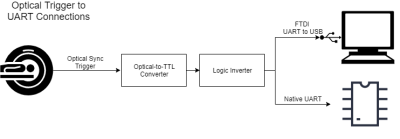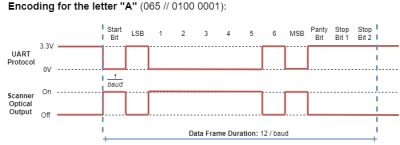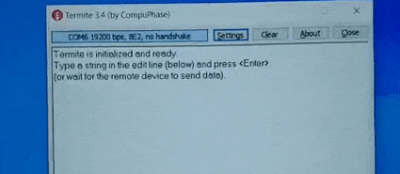1265
Misappropriation of the Scanner Synchronization Trigger for Serial Communication with any UART Device
Andrew Dupuis1, Dominique Franson1, Nicole Seiberlich2, and Mark A Griswold1,3
1Biomedical Engineering, Case Western Reserve University, Cleveland, OH, United States, 2Radiology, University of Michigan, Ann Arbor, MI, United States, 3Department of Radiology, School of Medicine, Case Western Reserve University, Cleveland, OH, United States
1Biomedical Engineering, Case Western Reserve University, Cleveland, OH, United States, 2Radiology, University of Michigan, Ann Arbor, MI, United States, 3Department of Radiology, School of Medicine, Case Western Reserve University, Cleveland, OH, United States
Synopsis
Clinical MRI scanners are not designed to allow for easy communication with 3rd party devices, whether for development or clinical purposes. However, most modern scanners provide a synchronization trigger interface that is sequence (and therefore research-user) controllable. We investigated using the synchronization trigger as a serial data output for arbitrary data, and successfully implemented a 192 kilobaud simplex serial interface that can be implemented within any sequence to enable arbitrary data transfer to and control of any external UART device. This opens significant opportunities for 3rd party hardware and software research without manufacturer consent or firmware changes.
Purpose
Verbose communication between MRI scanners and external hardware is difficult in a research environment while maintaining the regulatory approval of the scanner. There are few non-RF outputs on modern scanners that are user programmable at a sequence level. Outputs that do exist often require manufacturer consent or software extensions. However, nearly all MRI scanners can output synchronization triggers through a dedicated electrical or optical output. These simplistic on/off triggers are normally used to trigger fMRI stimuli or other hardware that operates in step with the scanner.We propose misappropriating this synchronization trigger by implementing a simplex TTL/UART serial protocol at the sequence level, allowing the scanner to transmit arbitrary data to an external device in real time. Via this method, hardware and software designers can have granular real time access to scanner operations and sequence debugging information via a verbose, temporally-synced output. This would greatly assist the development of 3rd-party hardware or software integrations that operate synchronously with the scanner without affecting regulatory approval.
Methods
Development occurred on a 3T clinical scanner (Skyra, Siemens Healthineers). A sequence level serial encoder was developed that respects the UART (Universal asynchronous receiver-transmitter) protocol.Generally, the duration and start times of synchronization pulses can be programmed within a sequence. While UART is idle high, most synchronization triggers are idle low. Therefore, we encode the inverse of the desired signal, then convert from an optical to electrical TTL signal and finally use a hardware logic inverter. See Figure 1 for a system diagram.
A standard UART 8-E-2 frame (one start bit, eight bits of data, one even parity bit, two stop bits) was implemented for data and timing robustness. Figure 2 shows a sample encoding pattern. Setting T to the scanner’s real-time clock as the start of a UART frame, each bit can be scheduled at T + iB, with i representing the index of the bit within the frame. Only “high” bits need to be scheduled due to the idle low behaviour of the sync trigger. For more complex transmissions, such as full strings or byte arrays, a function was written to schedule sequential synchronization events. The total transmission time for data with number of frames/bytes n is given by:
String transmission time = 12*n/baud rate
Baud rate, or the number of bits sent per second, is the largest determinant of bandwidth. The baud rate’s effect on stability was tested experimentally with an off-the-shelf USB-to-serial adapter with support for up to 12 megabaud. Communication was tested with two experiments. First, we programmed a static string variable directly into the sequence at the beginning of the first repetition time (TR). Baud rates from 1220 to 512000 were tested to determine if communication succeeded. Second, we envisioned measuring online reconstruction times for individual real-time acquisition slices by serializing a unique seven-character identification string prior to the acquisition of each slice, providing verbose sequence status information to the external reconstruction machine. The duration of a real-time cardiac sequence with very short TRs was measured at each baud rate to determine the effect of the serial communication routine on time sensitive scans. Figure 3 shows the example cardiac pulse sequence diagram, including the UART scheduling.
Results
An 11-character test string was received repeatably, with accurate encoding/decoding of byte data at baud rates of up to 115200. For a sequence with TR=500ms, there was no noticeable delay in sequence execution for any baud rate tested. Above 115200, bit-flips and timing inaccuracy led to incorrect ASCII characters or incorrect parity bits.In our second experiment, the unique slice identifiers were also accurately received at baud rates up to 115200. Whenever transmission time exceeded TR, an acquisition delay was introduced inverse to the baud rate. Increasing baud rate resolved the delay - see Figure 4 for delay data versus baud rates.
Discussion
We have shown that the sync trigger can be used for simplex serial data output from the scanner in an acquisition-locked manner. Arbitrary data transmission was reliable at baud rates up to 115200, although that limit may be due to the signal conversion / inversion hardware.For a prototypical scan with a TR of 1000ms its possible to transfer 960 bytes of raw data per TR at a baud rate of 115200 without introducing sequence delay, compared to 1 bit of data per TR currently sent by the synchronization pulse. As data packets can be scheduled with events inside of each TR, this approach greatly expands the scanner’s output capabilities without scanner hardware or firmware modification.
Data scheduling must be considered in order to prevent noticeably slower acquisition times due to packet transmission. When transmission time exceeds a scan’s TR, the sequence execution time is artificially increased. However, due to the larger number of TRs per second, bandwidth can be recovered by splitting large data packets across sequential TRs, resolving the delay issue.
Serial encoding opens pathways to integrating custom hardware and software with existing commercial scanners without manufacturer consent or regulatory issues However, further research is needed to enable full duplex communication at a sequence level; inputs such as the ECG gating system might be able to be similarly misappropriated.
Acknowledgements
Siemens Healthcare, R01EB018108, NSF 1563805, R01DK098503, and R01HL094557.References
No reference found.Figures

Figure 1: A
system diagram for our implemented conversion of the Optical sync
trigger to TTL 3.3V line level signal, followed by logic inversion into a
UART-compliant serial signal. Once UART-compliant, the serial signal
could be used by any UART-capable device such as a microcontroller, or
could be read by a serial-to-usb converter into a virtual COM port for
use by a software package.

Figure 2:
A signal diagram showing the generation and inversion of the desired
UART signal into an optical output that can be played out by the
synchronization trigger of the scanner. The length of a single bit is
given by 1/baud, and the total duration of a frame is the sum of all the
separate bits, 12/baud. Each of the UART 8-E-2 frames has one start
bit, followed by the byte in least-first order, followed by an even
parity bit and two stop bits.
Figure 3:
In this example sequence 7 bytes identifying the current repetition and
slice number of an acquisition are serialized. The time to transfer 7
bytes is 12 bitsx7/baud rate. At baud rate=38400, the transfer time is
2.19 ms. At a baud rate=19200, the transfer takes 4.28 ms. Output starts
at the beginning of the first TR and continues while events such as RF
pulses are played. With a fast enough baud rate, data output doesn’t
affect sequence timing (top). If the baud rate is too slow, the time
required to transfer the 7 packets will exceed the TR and lengthen the
first TR of the image (bottom).
Figure 4: Using
a stopwatch we conducted a test to determine the total sequence
execution time for a realtime cardiac acquisition (TR=2.88ms, 16 Readout
Lines/Frame, 1000 measurements), then divided to find the experimental
TR versus actual TR. The Average TR time approaches the actual TR value
as baud rate increases, and the average delay follows a logarithmic
decay until the baud rate is high enough to allow all data to be
transmitted within a single TR. Improved data transmission scheduling to
avoid "overrunning" the TR of the sequence would therefore resolve all
data transfer delays.

Figure 5: An
animated GIF demonstrating the 19200 baud simplex serial communication
system outputting realtime slice identifiers from a cardiac MRI
sequence.